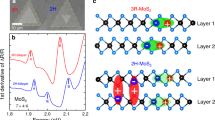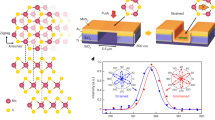Abstract
Stacking order in van der Waals materials determines the coupling between atomic layers and is therefore the key to materials’ properties. Recently, ferroelectricity, a phenomenon exhibiting reversible spontaneous electrical polarization, has been observed in zero-degree aligned van der Waals structures. In these artificial stacks, the single-domain size is limited by angle misalignment. Here we show that naturally rhombohedrally stacked MoS2 can host a homogeneous spontaneous polarization throughout the exfoliated flakes, free of misalignment. Utilizing this homogeneous polarization and its induced depolarization field, we build a graphene–MoS2-based photovoltaic device with high efficiency. Few-layer MoS2 is thinner than most oxide-based ferroelectric films, which allows us to maximize the depolarization field and study its impact at the atomically thin limit, whereas the highly uniform polarization in the commensurate crystal enables a tangible path for upscaling. The external quantum efficiency of our device is up to 16% at room temperature, over one order larger than the highest efficiency observed in bulk photovoltaic devices, owing to the reduced screening in graphene, exciton-enhanced light–matter interaction and ultrafast interlayer relaxation. Our findings make rhombohedral transition metal dichalcogenides a promising candidate for applications such as energy-efficient photodetection with high speed and programmable polarity.
This is a preview of subscription content, access via your institution
Access options
Access Nature and 54 other Nature Portfolio journals
Get Nature+, our best-value online-access subscription
$29.99 / 30 days
cancel any time
Subscribe to this journal
Receive 12 print issues and online access
$209.00 per year
only $17.42 per issue
Buy this article
- Purchase on Springer Link
- Instant access to full article PDF
Prices may be subject to local taxes which are calculated during checkout




Similar content being viewed by others
Data availability
Source data are provided with this paper. The data that support the plots within this paper and other findings of this study are available via Zenodo at https://doi.org/10.5281/zenodo.6416128.
Code availability
The codes that support the plots within this paper and other findings of this study are available via Zenodo at https://doi.org/10.5281/zenodo.6416128.
References
Cao, Y. et al. Unconventional superconductivity in magic-angle graphene superlattices. Nature 556, 43–50 (2018).
Sharpe, A. et al. Emergent ferromagnetism near three-quarters filling in twisted bilayer graphene. Science 365, 605–608 (2019).
Tang, Y. et al. Simulation of Hubbard model physics in WSe2/WS2 moiré superlattices. Nature 579, 353–358 (2020).
Regan, E. et al. Mott and generalized Wigner crystal states in WSe2/WS2 moiré superlattices. Nature 579, 359–363 (2020).
Woods, C. et al. Charge-polarized interfacial superlattices in marginally twisted hexagonal boron nitride. Nat. Commun. 12, 347 (2021).
Yasuda, K., Wang, X., Watanabe, K., Taniguchi, T. & Jarillo-Herrero, P. Stacking-engineered ferroelectricity in bilayer boron nitride. Science 372, 1458–1462 (2021)
Stern, M. et al. Interfacial ferroelectricity by van der Waals sliding. Science 372, 1462–1466 (2021)
Zheng, Z. et al. Unconventional ferroelectricity in moiré heterostructures. Nature 588, 71–76 (2020).
Tsymbal, E. Two-dimensional ferroelectricity by design. Science 372, 1389–1390 (2021).
Chen, G. et al. Evidence of a gate-tunable Mott insulator in a trilayer graphene moiré superlattice. Nat. Phys. 15, 237–241 (2019).
Shi, Y. et al. Electronic phase separation in multilayer rhombohedral graphite. Nature 584, 210–214 (2020).
Zhou, H., Xie, T., Taniguchi, T., Watanabe, K. & Young, A. F. Superconductivity in rhombohedral trilayer graphene. Nature 598, 434–438 (2021).
Suzuki, R. et al. Valley-dependent spin polarization in bulk MoS2 with broken inversion symmetry. Nat. Nanotechnol. 9, 611–617 (2014).
Zhao, M. et al. Atomically phase-matched second-harmonic generation in a 2D crystal. Light Sci. Appl. 5, e16131 (2016).
Lopez-Varo, P. et al. Physical aspects of ferroelectric semiconductors for photovoltaic solar energy conversion. Phys. Rep. 653, 1–40 (2016).
Sipe, J. & Shkrebtii, A. Second-order optical response in semiconductors. Phys. Rev. B 61, 5337 (2000).
Yang, M., Kim, D. & Alexe, M. Flexo-photovoltaic effect. Science 360, 904–907 (2018).
Zhang, Y. et al. Enhanced intrinsic photovoltaic effect in tungsten disulfide nanotubes. Nature 570, 349–353 (2019).
Osterhoudt, G. et al. Colossal mid-infrared bulk photovoltaic effect in a type-I Weyl semimetal. Nat. Mater. 18, 471–475 (2019).
Akamatsu, T. et al. A van der Waals interface that creates in-plane polarization and a spontaneous photovoltaic effect. Science 372, 68–72 (2021).
Mehta, R., Silverman, B. & Jacobs, J. Depolarization fields in thin ferroelectric films. J. Appl. Phys. 44, 3379–3385 (1973).
Qin, M., Yao, K. & Liang, Y. High efficient photovoltaics in nanoscaled ferroelectric thin films. Appl. Phys. Lett. 93, 122904 (2008).
Yang, S. et al. Above-bandgap voltages from ferroelectric photovoltaic devices. Nat. Nanotechnol. 5, 143–147 (2010).
Nechache, R. et al. Bandgap tuning of multiferroic oxide solar cells. Nat. Photon. 9, 61–67 (2015).
Batra, I., Wurfel, P. & Silverman, B. Phase transition, stability, and depolarization field in ferroelectric thin films. Phys. Rev. B 8, 3257 (1973).
Wurfel, P. & Batra, I. Depolarization-field-induced instability in thin ferroelectric films—experiment and theory. Phys. Rev. B 8, 5126 (1973).
Fong, D. et al. Ferroelectricity in ultrathin perovskite films. Science 304, 1650–1653 (2004).
Qin, M., Yao, K. & Liang, Y. Photovoltaic mechanisms in ferroelectric thin films with the effects of the electrodes and interfaces. Appl. Phys. Lett. 95, 022912 (2009).
Wang, Y., Wang, Z., Yao, W., Liu, G. & Yu, H. Interlayer coupling in commensurate and incommensurate bilayer structures of transition-metal dichalcogenides. Phys. Rev. B 95, 115429 (2017).
Andersen, T. et al. Excitons in a reconstructed moiré potential in twisted WSe2/WSe2 homobilayers. Nat. Mater. 20, 480–487 (2021)
Sung, J. et al. Broken mirror symmetry in excitonic response of reconstructed domains in twisted MoSe2/MoSe2 bilayers. Nat. Nanotechnol. 15, 750–754 (2020).
Kormányos, A., Zólyomi, V., Fal’ko, V. & Burkard, G. Tunable Berry curvature and valley and spin Hall effect in bilayer MoS2. Phys. Rev. B 98, 035408 (2018).
Mak, K., Lee, C., Hone, J., Shan, J. & Heinz, T. Atomically thin MoS2: a new direct-gap semiconductor. Phys. Rev. Lett. 105, 136805 (2010).
Yu, W. et al. Highly efficient gate-tunable photocurrent generation in vertical heterostructures of layered materials. Nat. Nanotechnol. 8, 952–958 (2013).
Britnell, L. et al. Strong light-matter interactions in heterostructures of atomically thin films. Science 340, 1311–1314 (2013).
Gregg, B. Excitonic solar cells. J. Phys. Chem. B 107, 4688–4698 (2003).
Ju, L. et al. Topological valley transport at bilayer graphene domain walls. Nature 520, 650–655 (2015).
Britnell, L. et al. Field-effect tunneling transistor based on vertical graphene heterostructures. Science 335, 947–950 (2012).
Xu, X., Gabor, N., Alden, J., Van Der Zande, A. & McEuen, P. Photo-thermoelectric effect at a graphene interface junction. Nano Lett. 10, 562–566 (2010).
Freitag, M., Low, T., Xia, F. & Avouris, P. Photoconductivity of biased graphene. Nat. Photon. 7, 53–59 (2013).
Koppens, F. et al. Photodetectors based on graphene, other two-dimensional materials and hybrid systems. Nat. Nanotechnol. 9, 780–793 (2014).
Park, J. et al. Optical control of the layer degree of freedom through Wannier–Stark states in polar 3R MoS2. J. Phys.: Condens. Matter 31, 315502 (2019).
Yu, W. et al. Unusually efficient photocurrent extraction in monolayer van der Waals heterostructure by tunnelling through discretized barriers. Nat. Commun. 7, 13278 (2016).
Jin, C. et al. Ultrafast dynamics in van der Waals heterostructures. Nat. Nanotechnol. 13, 994–1003 (2018).
Lee, C. et al. Atomically thin p–n junctions with van der Waals heterointerfaces. Nat. Nanotechnol. 9, 676–681 (2014).
Mak, K. & Shan, J. Photonics and optoelectronics of 2D semiconductor transition metal dichalcogenides. Nat. Photon. 10, 216–226 (2016).
Wang, G. et al. Colloquium: excitons in atomically thin transition metal dichalcogenides. Rev. Mod. Phys. 90, 021001 (2018).
Wang, L. et al. One-dimensional electrical contact to a two-dimensional material. Science 342, 614–617 (2013).
Ju, L. et al. Photoinduced doping in heterostructures of graphene and boron nitride. Nat. Nanotechnol. 9, 348–352 (2014).
Acknowledgements
Z.Y., D.Y., J.W., J.L., B.T.Z., M.F., T.S. and K.M.A. acknowledge support from the Natural Sciences and Engineering Research Council of Canada, Canada Foundation for Innovation, New Frontiers in Research Fund, Canada First Research Excellence Fund and Max Planck-UBC-UTokyo Centre for Quantum Materials. Z.Y. is also supported by the Canada Research Chairs Program. B.T.Z. and M.F. acknowledge Quantum Materials and Future Technologies Program, and the Croucher Foundation. Y.I. acknowledges support from JSPS Grant-in-Aid for Scientific Research (S) (JP19H05602) and the A3 Foresight Program. T.I. acknowledges Grant-in-Aid for Scientific Research on Innovative Areas (JP20H05264), Grant-in-Aid for Scientific Research (B) (JP19H01819) and JST PRESTO (JPMJPR19L1). K.W. and T.T. acknowledge support from JSPS KAKENHI (grant nos. 19H05790, 20H00354 and 21H05233). We would like to thank J. Dadap, Z. Wang, J. Folk, D. Jones, G. Sawatzky, A. Damascelli and T. Cao for helpful discussion.
Author information
Authors and Affiliations
Contributions
Z.Y. and D.Y. conceived this work. D.Y., T.S., J.W. and K.M.A. fabricated the sample. D.Y., J.W. and J.L. conducted the measurement under supervision from Z.Y. B.T.Z. performed the theoretical calculation under supervision from M.F. and Z.Y. T.I., Y.I., K.W. and T.T. provided the bulk crystal. Z.Y., D.Y. and J.W. analysed the data. Z.Y. and D.Y. wrote the manuscript based on inputs from all the other authors.
Corresponding author
Ethics declarations
Competing interests
The authors declare no competing interests.
Peer review
Peer review information
Nature Photonics thanks the anonymous reviewers for their contribution to the peer review of this work.
Additional information
Publisher’s note Springer Nature remains neutral with regard to jurisdictional claims in published maps and institutional affiliations.
Extended data
Extended Data Fig. 1 Thermal Background of Photocurrent.
Extracted thermal contributions of the AB (top panel) and BA (bottom panel) domains. The straight lines with negative slopes are due to the bolometric effect IBOL, which crosses zero at zero bias. The non-zero intercept is caused by the photo-thermal electric effect IPTE, which is opposite in direction to IPV. The IPTE is approximately independent with bias.
Extended Data Fig. 2 Photocurrent I-V curve of 2H Bilayer.
Bias dependence of photocurrent in the 2H bilayer device, C1. With a similar laser illumination condition (P=20 μW), C1 shows a nearly zero photocurrent at zero bias. The photocurrent linearly increases with bias, with no thermal contribution observed.
Supplementary information
Supplementary Information
Supplementary Figs. 1–11, Sections 1–15 and refs. 1–29.
Source data
Source Data Fig. 1
Experimental source data.
Source Data Fig. 2
Experimental source data.
Source Data Fig. 3
Experimental source data.
Source Data Fig. 4
Simulation results and experimental source data.
Source Data Extended Data Fig. 1
Extracted data from the global fitting in Fig. 3.
Source Data Extended Data Fig. 2
Experimental source data.
Rights and permissions
About this article
Cite this article
Yang, D., Wu, J., Zhou, B.T. et al. Spontaneous-polarization-induced photovoltaic effect in rhombohedrally stacked MoS2. Nat. Photon. 16, 469–474 (2022). https://doi.org/10.1038/s41566-022-01008-9
Received:
Accepted:
Published:
Issue Date:
DOI: https://doi.org/10.1038/s41566-022-01008-9
This article is cited by
-
Giant intrinsic photovoltaic effect in one-dimensional van der Waals grain boundaries
Nature Communications (2024)
-
Non-volatile electrical polarization switching via domain wall release in 3R-MoS2 bilayer
Nature Communications (2024)
-
Quantifying the photocurrent fluctuation in quantum materials by shot noise
Nature Communications (2024)
-
Strong bulk photovoltaic effect in engineered edge-embedded van der Waals structures
Nature Communications (2023)
-
0D van der Waals interfacial ferroelectricity
Nature Communications (2023)



